1) 雷神図 (無銘)
Design of the god of thunder, Rai-jin (unsigned)
|
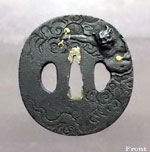 |
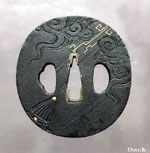 |
寸法: 縦75.5×横71.5厚さ7.0 (mm)
雷太鼓を勇ましく叩く雷神と突然の夕立と稲妻から逃れ走り去る人物を表裏に描いた洒落た構図。古来より雷(神鳴り)に対し自分より強い不可抗の力を持つ存在として畏怖と尊敬の念を持っていた。江戸時代後期。
A stylish design that depicts the god of thunder (Rai-jin) who is beating
the drums and a person who is running from the sudden thunder and evening
shower rain. People of the time have a feeling of awe and respect against
Rai-jin which have an irresistible power of nature. 19c.
|
2) 酸漿に蟻図 加賀後藤(無銘)
Design of Hoozuki (lantern plant) with ants by Kaga-goto school |
 |
 |
寸法: 縦14.0×横97.0 (mm)
ホオズキは古くから薬草として伝わる。「ホオズキ市」は愛宕神社(東京港区)6月の功徳日「千日参り」縁日でホオズキが売られ賑わったことが起源で、大本である浅草寺7月の「四万六千日」はじめ寺院に云わり初夏の風物詩であった。前田家より招聘され活躍した後藤家による優品。
裏面の金象嵌に加賀の上品な華やかさを感じる。江戸時代中期。特別保存鑑定書付。
Hoozuki (lantern plant) is useful as a medicinal herb for long time. The origin of Hoozuki Festival in June, is the Atago Shrine at Minato-ku, Tokyo, and is regarded as a summer tradition. It is an excellent Kozuka by Kaga-Goto School which was invited by Maeda Family in Kaga (Ishikawa.), and shows elegant gold flat inlay work on the back. 18c. With Tokubetsu Hozon certificate paper.
|
3) 蝸牛図鐔 無銘
Design of snail (unsigned)
NEW |
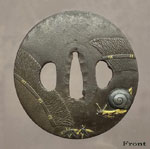 |
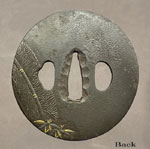 |
寸法:縦 75.5×横73.0×厚さ5.0 (mm)
蝸牛 (カタツムリ)は国持ち、家持ちの象徴として武士に好まれた。
殻の渦巻きは途切れることのないことから「再生」「復活」を表す吉祥模様。
江戸時代中期。
Snail is regarded as a symbol of the owner of a castle or house. Shell
spiral is uninterrupted design.
It is an auspicious that represents "rebirth" and "revival." 18c.
|
4) 縁頭 蝸牛図
Design of a snail |
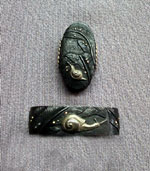 |
(縁) 縦39.0×横24.5×厚さ11.5 (mm) (頭) 縦32.0×横18.5×厚さ0.9 (mm)
梅雨の頃であろうか、葉の上にある雨の露を金象嵌で表現し、カタツムリが 可愛らしく描写されている。また殻を持つその姿から家・国持ちの象徴とされ、縁起が良い。江戸時代中期。
Design of a snail having a husk is considered to be the symbol of the owner
of a house or a country.This is a seasonable design of the rainy season
in June. Depicted snails are so cute and drops of dew (gold inlay parts)
can be seen on the leaves are good accent.18th centu
|